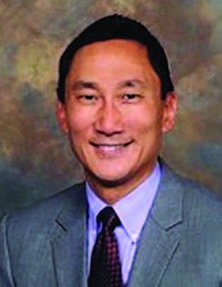Although nothing since has come close to those early pandemic days, ongoing frustrations continue to escalate. Each surge comes with sudden, all-consuming, frenetic work that feels like it should have been avoidable.
Explore This Issue
March 2022On a personal level, I always swore I wouldn’t become the stereotypical physician/surgeon/father who was never or rarely present for his children’s activities. I had started to carve out more time from professional obligations just before the pandemic hit, but since then I’ve been derailed with ongoing challenges related to COVID-19.
 Daniel Choo, MD, division chief, pediatric otolaryngology–head and neck surgery, Cincinnati Children’s: Figuring out the proper prioritization balance between the safety and well-being of our patients, faculty, and staff was the most difficult challenge. For patients, it was prioritizing who needed to be seen and managed and who could be deferred. Life-and-death decisions on care were obvious; quality-of-life clinical decisions were more difficult.
Daniel Choo, MD, division chief, pediatric otolaryngology–head and neck surgery, Cincinnati Children’s: Figuring out the proper prioritization balance between the safety and well-being of our patients, faculty, and staff was the most difficult challenge. For patients, it was prioritizing who needed to be seen and managed and who could be deferred. Life-and-death decisions on care were obvious; quality-of-life clinical decisions were more difficult.
For faculty and staff, it was how to keep them safe while managing their different risk tolerances—some didn’t want to see patients in person, others were happy to see everyone as normal; some wanted full PPE, while others thought that was ridiculous. And as things dragged on, it was hard to keep everyone financially whole when they were seeing a fraction of their normal patient load. I sidelined two of my older faculty members for a couple months due to their risk factors—but if I had them stop working, wasn’t I financially penalizing them at the same time?
The ripple effects were striking. Short term vs. immediate term, it was all about safety. Everything was disrupted and different. Nobody was acutely worried about how we would return back to normal. In the intermediate term, we shifted a bit to figuring out how to adjust to COVID-19—how we reintroduced aerosol-generating procedures into our clinics, how densely we scheduled patients, how we redeployed people to maximize safety and reduce exposure risks, etc. Long term, we integrated vaccination and booster status into our plans as we resumed operations. Our schedulers, pre-cert staff, and administrative assistants have all been working remotely from home, and that may or may not revert back to pre-COVID workflows. The cultural landscape has changed a lot.
JW: How were you able to accommodate increased demand on productivity amidst reduced resources and centralization?
Dr. Choo: We temporarily and partially shifted to a “generic physician” mode during COVID-19 peaks. Patients might see one MD in clinic but have another MD perform the surgery. Unlinking some patients from a particular physician allowed greater scheduling efficiency in the clinic and the OR. It was a big hit to patient–physician relationships and care continuity, but desperate times called for desperate measures.